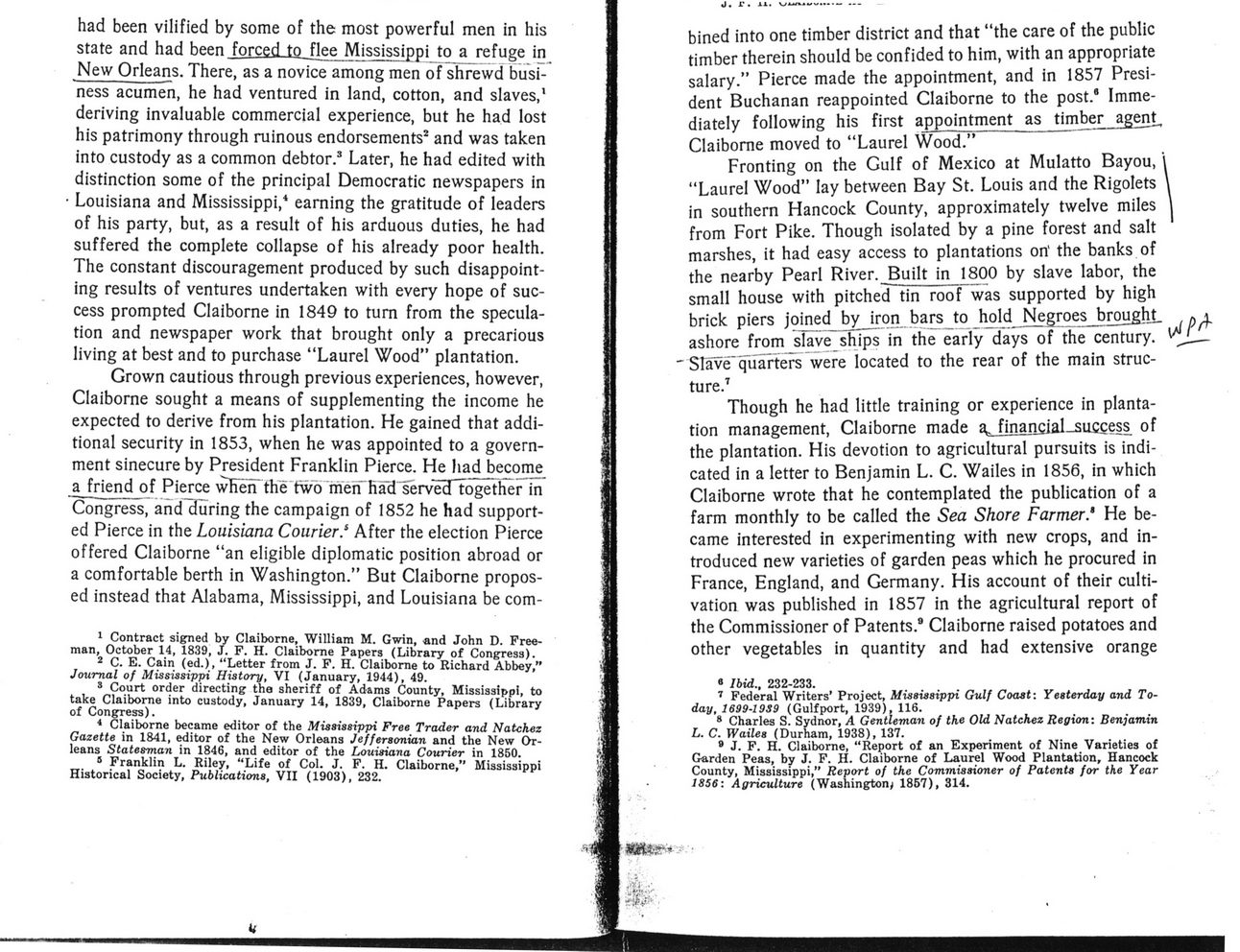This text was obtained via automated optical character recognition.
It has not been edited and may therefore contain several errors.
had been vilified by some of the most powerful men in his state and had been forced to flee Mississippi to a^refuge in_ New Orleans. There, as a novice among men of shrewd business acumen, he had ventured in land, cotton, and slaves,1 deriving invaluable commercial experience, but he had lost his patrimony through ruinous endorsements2 and was taken into custody as a common debtor.3 Later, he had edited with distinction some of the principal Democratic newspapers in Louisiana and Mississippi,4 earning the gratitude of leaders of his party, but, as a result of his arduous duties, he had suffered the complete collapse of his already poor health. The constant discouragement produced by such disappointing results of ventures undertaken with every hope of success prompted Claiborne in 1849 to turn from the speculation and newspaper work that brought only a precarious living at best and to purchase ?Laurel Wood? plantation. Grown cautious through previous experiences, however, Claiborne sought a means of supplementing the income he expected to derive from his plantation. He gained that additional security in 1853, when he was appointed to a government sinecure by President Franklin Pierce. He had become a friend of Pierce wHerTthe twoTrieri haH'serve^JTogether in Congress, and^uring the campaign of 1852 he had supported Pierce in the Louisiana Courier.* After the election Pierce offered Claiborne ?an eligible diplomatic position abroad or a comfortable berth in Washington.? But Claiborne proposed instead that Alabama, Mississippi, and Louisiana be com- 1 Contract signed by Claiborne, William M. Gwin, and John D. Freeman, October 14, 1839, J. F. H. Claiborne Papers (Library of Congress). 2 C. E. Cain (ed.), ?Letter from J. F. H. Claiborne to Richard Abbey,? Journal of Mississippi History, VI (January, 1944), 49. 3 Court order directing the sheriff of Adams County, Mississippi, to take Claiborne into custody, January 14, 1839, Claiborne Papers (Library of Congress). 4 Claiborne became editor of the Mississippi Free Trader and Natchez Gazette in 1841, editor of the New Orleans Jeffersonian and the New Orleans Statesman in 1846, and editor of the Louisiana Courier in 1850. 5 Franklin L. Riley, ?Life of Col. J. F. H. Claiborne,? Mississippi Historical Society, Publications, VII (1903), 232. bined into one timber district and that ?the care of the public timber therein should be confided to him, with an appropriate salary.? Pierce made the appointment, and in 1857 President Buchanan reappointed Claiborne to the post.8 Immediately following his first appointment as timber agent, Claiborne moved to ?Laurel Wood.? Fronting on the Gulf of Mexico at Mulatto Bayou, I ?Laurel Wood? lay between Bay St. Louis and the Rigolets \ in southern Hancock County, approximately twelve miles \ from Fort Pike. Though isolated by a pine forest and salt marshes, it had easy access to plantations on' the banks of the nearby Pearl River._Built in 1800 by slave labor, the small house with pitched tin roof was supported by high brick piers joined by iron bars to hold Negroes brought, ashore from slave ships in the early days of the century. Slavif Quarters were located to the rear of the main structure.7 Though he had little training or experience in plantation management, Claiborne made a. financial-success of the plantation. His devotion to agricultural pursuits is indicated in a letter to Benjamin L. C. Wailes in 1856, in which Claiborne wrote that he contemplated the publication of a farm monthly to be called the Sea Shore Farmer.* He became interested in experimenting with new crops, and introduced new varieties of garden peas which he procured in France, England, and Germany. His account of their cultivation was published in 1857 in the agricultural report of the Commissioner of Patents.9 Claiborne raised potatoes and other vegetables in quantity and had extensive orange 8 Ibid., 232-233. 7 Federal Writers? Project, Mississippi Gulf Coast: Yesterday and Today, 1S99-19S9 (Gulfport, 1939), 116. 8 Charles S. Sydnor, A Gentleman of the Old Natchez Region: Benjamin L. C. Wailes (Durham, 1938), 137. 9 J. F. H. Claiborne, ?Report of an Experiment of Nine Varieties of Garden Peas, by J. F. H. Claiborne of Laurel Wood Plantation, Hancock County, Mississippi,? Report of the Commissioner of Patents for the Year 1856: Agriculture (Washington^ 1857), 314.

Claiborne, J.F.H Claiborne-J.F.H-089